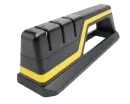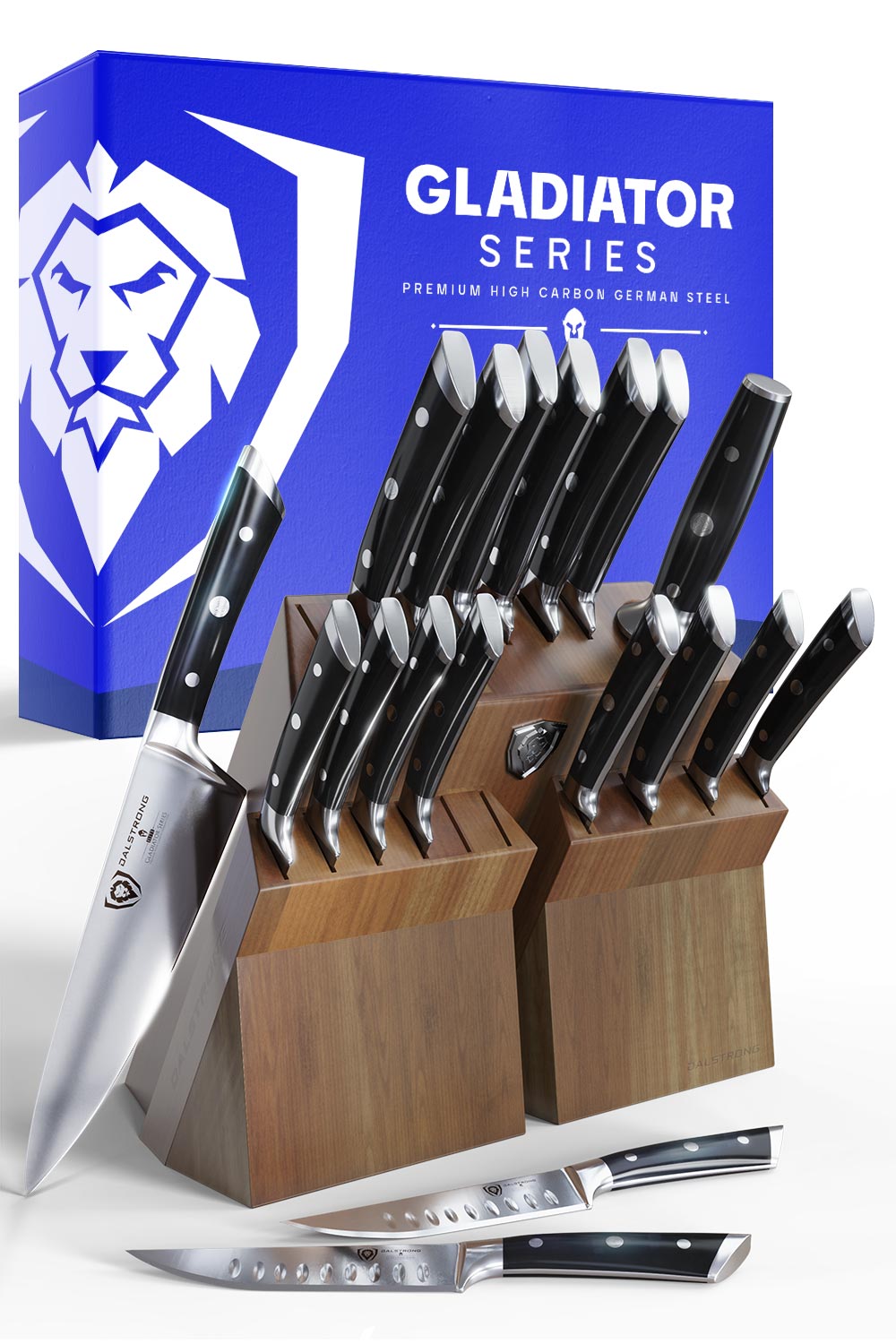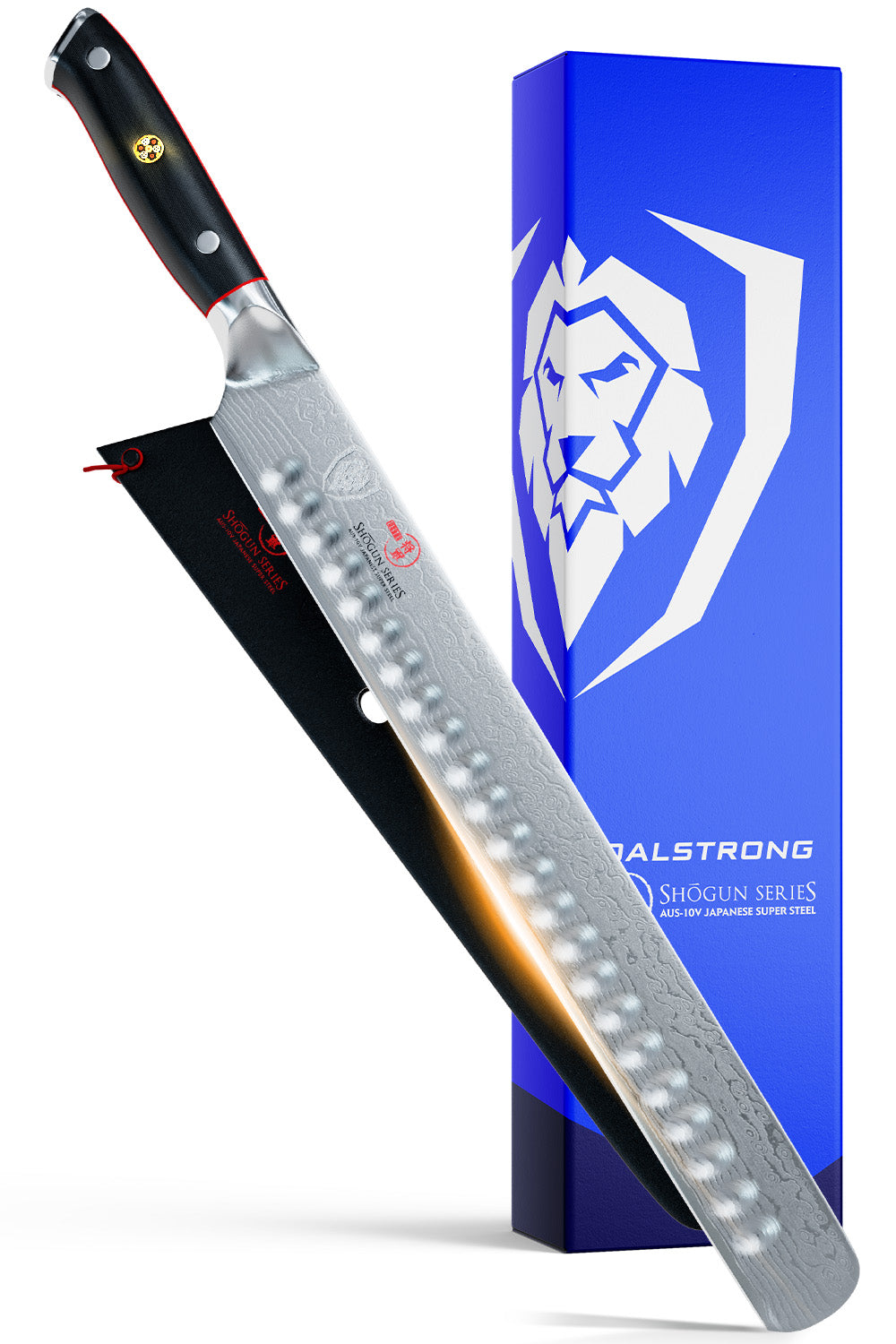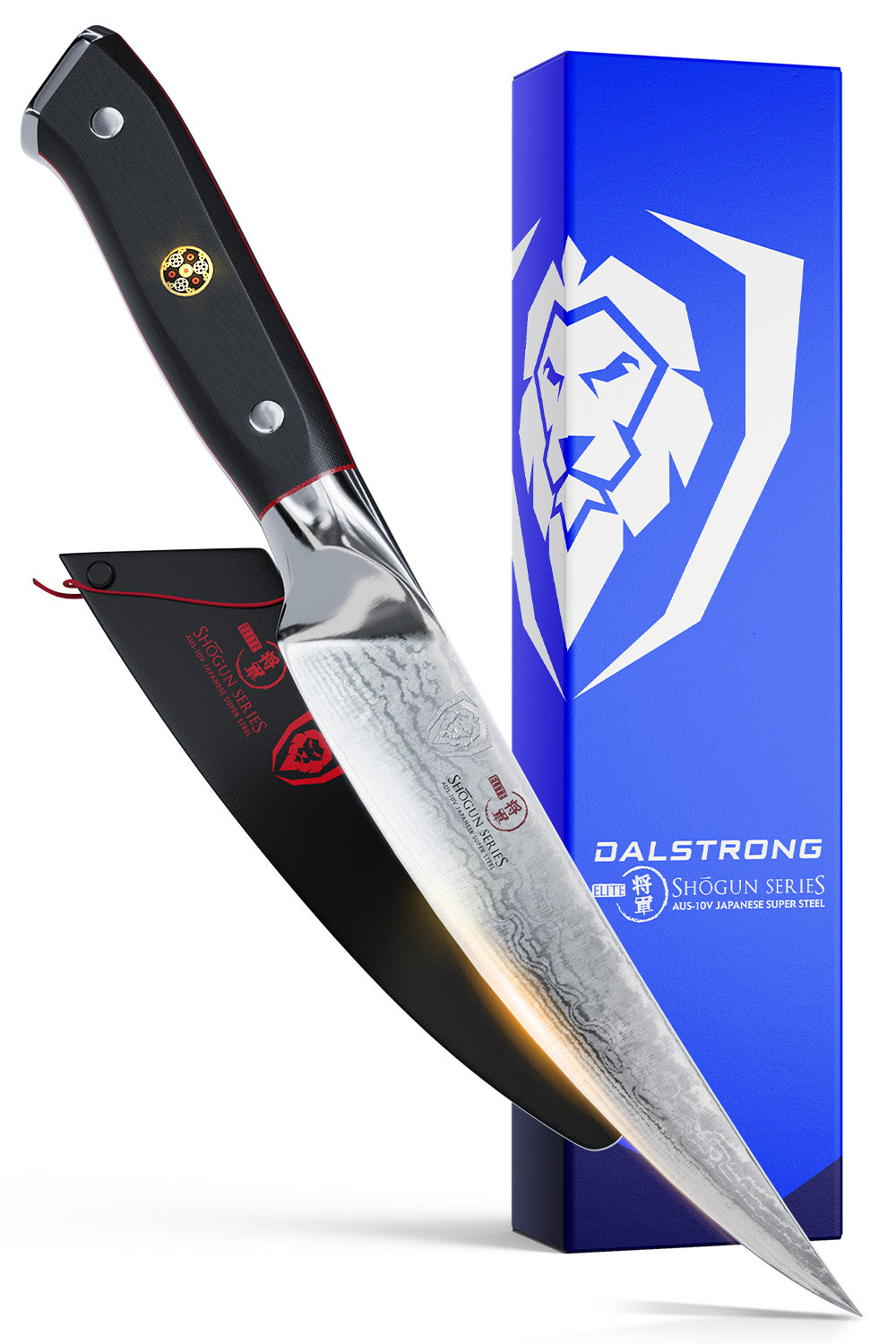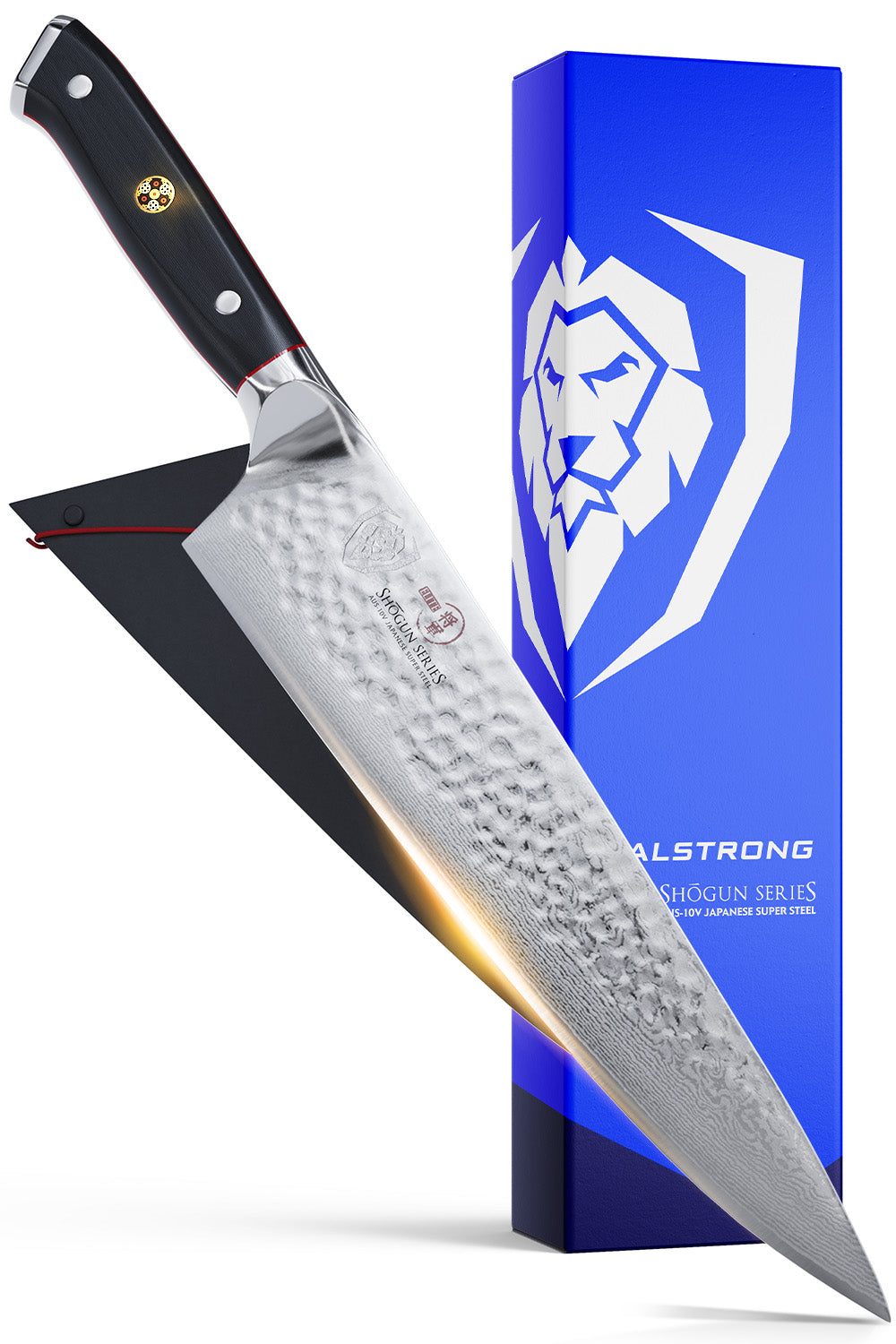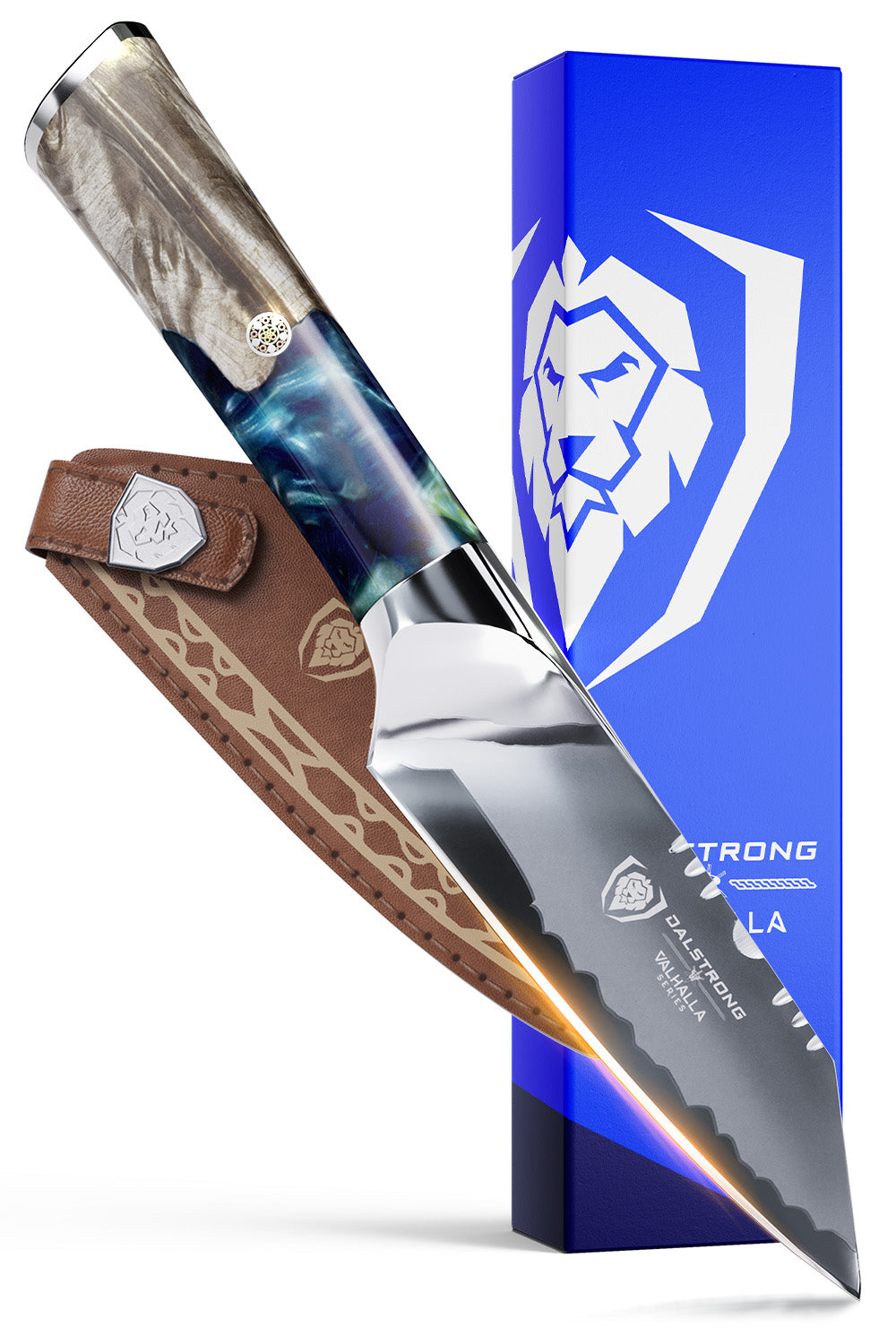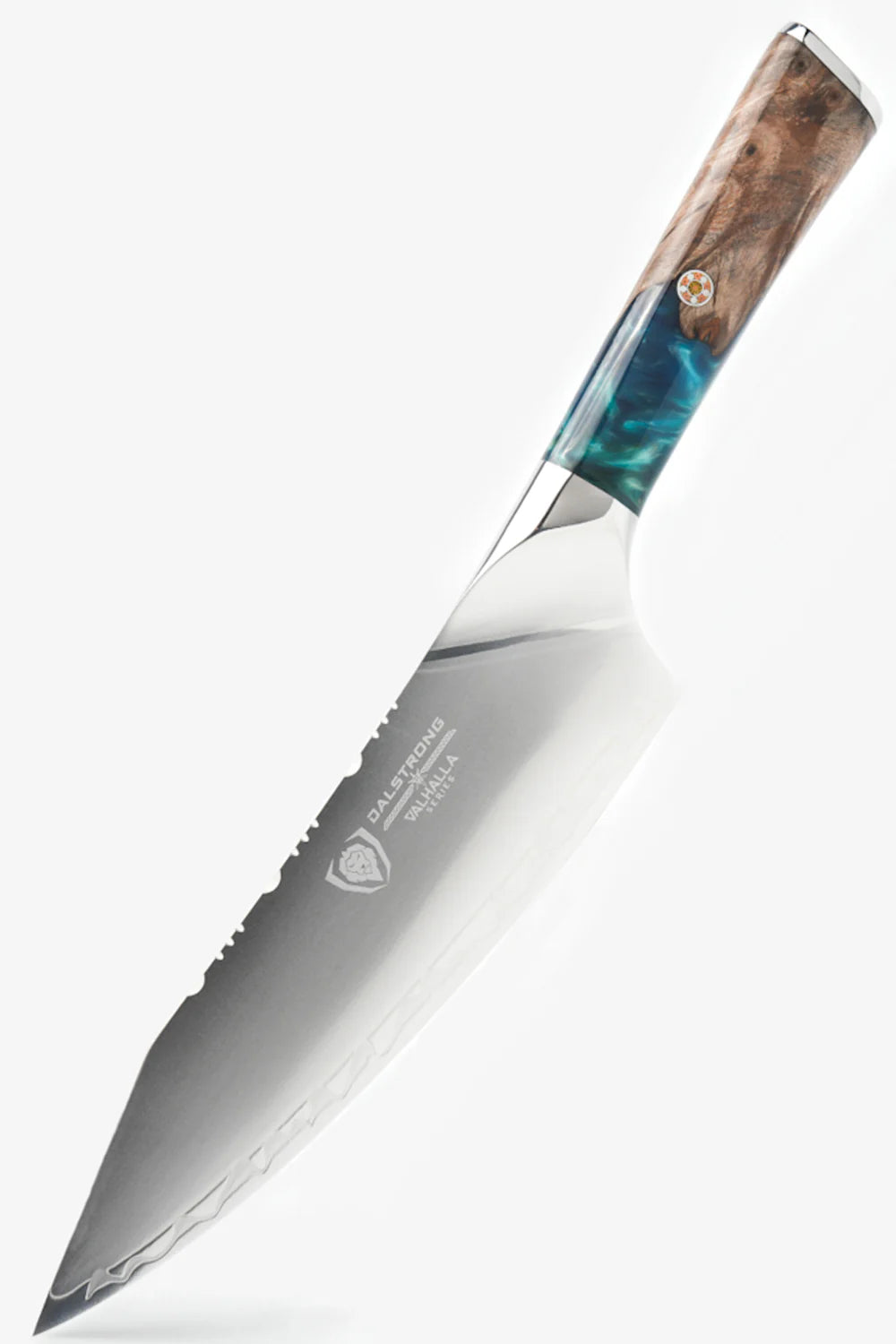Best Yanagiba Knives
- Yanagiba Slicer 9.5” | Phantom Series
- Yanagiba Knife 10.5” | Gladiator Series
- Yanagiba & Sushi Knife 10.5” | Ronin Series
10.5'' Yanagiba | Gladiator Series | Dalstrong ©
Something I really missed in the early days of Covid was going out to restaurants. I consider myself somewhat of a sushi aficionado. When my opportunity to consume mass quantities of sashimi was taken away I knew I’d have to pivot.
Like many who learned to bake the sourdough bread, I too searched for ways to enhance my culinary prowess. Instead of my regular Chef’s knife creations, I turned to the unsung heroes of my knife collection for inspiration.
Of all the Japanese knives I own, it was the Yanagiba knife that allowed me to cultivate an entirely new culinary skill and to turn my sushi making dreams into a reality.
The key to spectacular Japanese cuisine is, as always, fresh ingredients and the proper tools. Investing in a flawlessly sharp traditional Japanese knife with a ruthless cutting edge, a Yanagabi knife in particular, is absolutely necessary if you want to make sushi that’s anywhere near restaurant quality.
It’s important to know your knives and what they do. Let’s understand first and foremost what a Yanagiba Knife is and how it differs from any old regular kitchen knife. Next, we’ll take a look at all the ways we can use a Yanagiba in the kitchen. Then we’ll explore my top three recommendations for the best sushi knife. You’ll be off and slicing sashimi in no time.
1. What is a Yanagiba Knife?
9.5'' Yanagiba | Phantom Series | Dalstrong ©
Hailing from the Kansai region of Japan, the Yanagiba knife is one of the sleekest Japanese kitchen knives you can find. Known as the ultimate sushi knife, the term Yanagiba comes from the Japanese phrase for “willow leaf.” If you’ve ever seen the blade this makes complete sense as the Yanagiba knife (sometimes referred to as solely Yanagi) has a long and narrow blade much like a willow leaf.
The particularly slender blade shape of a Yanagiba is perfect for fluid, non stop slicing, therefore making this knife every sushi chef’s dream. Without the long blade, one could not gracefully slice through raw fish in one solid motion from top to bottom.
Typically the blade is only sharpened on one side, meaning it is referred to as a single bevel blade. Comparatively a relatively similar relative to the Yanagiba would be the Japanese Sujihiki knife. While the Yanagiba’s single bevel blades allow for precise cuts, fluid motion, and clean slicing every time, the Sujihiki’s double bevel provides a different kind of flair that similarly works for slicing through fresh meats and fish.
2. What is a Yanagiba Knife Used For?
10.5'' Yanagiba | Gladiator Series | Dalstrong ©
Used primarily to slice through raw sushi, the Yanagiba knife is the perfect knife for sashimi and nagiri sushi. In fact it’s sometimes referred to specifically as the sashimi knife. For those of you that don’t consume sushi at the rate I do, sashimi refers to those thin slices of raw fish and nagiri includes a bed of rice with a piece of raw fish on top.
Japanese sushi chefs will agree that in order to maintain both the flavor and original texture of raw fish this type of slender blade is absolutely essential. You are sure to find the Yanagiba knife in the best sushi kitchens or the average sushi enthusiast's home. That said, these types of knives can also be used to slice a large holiday meat (think roast beef or ham), skin your daily catch, or finely slice some sort of pate.
As they’ve gained popularity in the Western world, the Yanagiba knife has been used more and more to slice things like pork tenderloins, hanger steak, and raw poultry. If you’re looking for paper thin, clean cuts you can pretty much slice anything with a Yanagiba.
Additionally, these knives are incredibly slender and sharp meaning you could even use them to debone or slice through a raw whole chicken in a pinch. Though I’d recommend a solid cutting board, stylish apron, and butcher knife if you really want to get your hands bloody in the meat.
3. How to Use a Yanagiba
9.5'' Yanagiba | Phantom Series | Dalstrong ©
You use a Yanagiba (or Yanagi) knife like you would any other knife: carefully. These Japanese Yanagiba knives are absolute weapons that can slice cleanly through any type of fish. That said, they tend to be incredibly sharp to begin with and (if you are sharpening with the right whetstone) well taken care of.
Unlike those average serrated Western knives (think a bread knife, or utility knife) you’ll want to use a fluid motion when slicing with any Yanagiba. Instead of back and forth motion, think of any sushi chef you’ve ever watched sliced through a tuna or fresh salmon. You want it to be a confident and crisp cut that takes place one time only, otherwise you’ll leave your raw fish fillet an absolute mess.
Unlike a paring knife you won’t exactly want to dice with this kind of knife. Slicing is key.
Grab hold of the handle and make sure the sharp stainless steel blade is facing down. And as someone who recently cut themselves slicing an avocado pit, I have to say that if you’ve been sharpening the knife recently as I hope you have please remind yourself to take extra precautions with your fingers.
Once safety precautions are accounted for go ahead and make a cut from tip to finish, in one fluid motion. Obviously if you’re slicing something other than sushi you have a bit more play room to work with but the slenderness of the blade makes the one motion chop quite easy.
4. Our Top Three Yanagiba Knife Recommendations
Sushi lover or not, you need a Yanagiba knife (also known as Yanagi knife) in your kitchen arsenal. Slightly thicker than a Sujihiki knife, it is the perfect sashimi knife, the slender beacon of kitchen truth. This is the graceful kitchen cutlery whose stainless steel long blade brings honor to your culinary spaces. Its slender willow blade is both beautiful and intimidating to those who don’t trust their own knife strokes, but the best companion to those who do.
1. Yanagiba Slicer 9.5” | Phantom Series
The perfect addition to any knife set, the Yanagiba slicer makes all the other Japanese knives look simply less cool. Its single bevel blade and ice tempered stainless steel is the stunningly slick Japanese sushi knife that can tackle all your sashimi needs.
Pros
- The white steel blade of this particular Yanagiba is slightly thicker than your average kitchen cutlery meaning its full tang heft makes for crisp, precise cuts every time.
- As someone with smaller hands I find the slenderness and 9.5” inch stainless steel blade the perfect blade length. It is long, but not overwhelmingly so.
- This knife just looks sharp with its traditional Japanese D-shaped black pakkawood handle that incorporates an extra cap of steel on its end for an added bit of style. Pair that with its traditional Japanese writing on the blade and you’ll be the talk of the kitchen scene.
Cons
- If you prefer a slightly longer white steel knife blade, consider the Yanagiba Knife 10.5” | Gladiator Series with its extra inch of blade.
- While sitting at an incredibly reasonable price point, for those looking to spend a bit less they may want to consider a again the Yanagiba Knife 10.5” | Gladiator Series.
- A fantastic knife for clean fluid slicing, some chefs prefer a more multipurpose knife than the slender blade of the Yanagiba. In that case I’d recommend another Japanese knife, perhaps with a soft iron or a Santoku that offers a wider range.
2. Yanagiba Knife 10.5” | Gladiator Series
Conquer the kitchen with 10.5” inches of German stainless steel. Its bold, yet classic black handle and sleek, long blade is ready to tackle raw fish, poultry, or meat with ease and comfortability.
Pros
- Its ergonomic, ambidextrous black G10 Garolite handle makes for a comfortable slice every single time.
- For those who prefer as slender and long of a blade as they can get when cutting paper thin slices of sashimi, this 10.5” blade is the absolute perfect size.
- With its incredibly reasonable price point for such a professional kitchen tool, this knife is accessible for sushi chefs just starting out.
Cons
- While a Japanese inspired knife, this particular series has a high carbon steel blade from Germany, rather than the traditional Japanese carbon steel that the Phantom Series offers.
- Its stainless steel and black handle has a classic kitchen look, but if you’re looking to step up the style points I’d consider the Yanagiba & Sushi Knife 10.5” | Ronin Series.
- The perfect knife for slicing sushi or a hanger steak, this knife (due to its length) tends to be slightly less maneuverable than your average paring knife.
3. Yanagiba & Sushi Knife 10.5” | Ronin Series

If you’re looking for style and a sashimi slayer look no further than this beast of a knife. Made with three main grinds forged from Japanese high-carbon AUS-10V steel this is the ultimate of Yanagiba knives.
Pros
- The three main grinds each do their part to ensure the highest quality knife, but the second layer in particular, the Urasuki on the backside of the blade, makes this the ideal knife for sashimi. It ensures a minimal drag and a smoother surface, minimizing tearing or pulling of any kind.
- This Japanese white steel is the absolute finest quality, with cryogenic tempering with liquid nitrogen meaning a knife can’t get sharper or stronger than this without still maintaining its flexibility.
- I think of all the Yanagiba knives I’ve seen, this is by far the most handsome looking. With its hot-forged “Liquid-Kusari” pattern and chic handle, you can elevate even the drearitest of kitchens when you whip this kitchen utensil out.
- This stunning knife is worth every penny, but for those looking to spend less I’d consider the Yanagiba Knife 10.5” | Gladiator Series.
- If you’re looking for a slightly smaller blade, the Yanagiba Slicer 9.5” | Phantom Series may be a better option for you.
- As beautiful as this nice looks it may intimidate some. If you’re looking for something a bit more humble try scouring a lower stakes Chef’s knife.
5. Frequently Asked Questions
10.5'' Yanagiba | Gladiator Series | Dalstrong ©
What is a Yanagiba knife used for?
Historically the Yanagiba knife has been used by Japanese chefs to slice sashimi or other varieties. That said, it has since been used to slice a variety of proteins from pork to chicken to steak.
What is a Kiritsuke for?
Another Japanese classic, the Kiritsuke is widely known for dicing vegetables, slicing raw fish, cutting herbs, or slicing far meat. It is often referred to as the child of the Usuba and Yanagiba, because while it chops veggies like the Usuba it can slice through meat like a Yanagiba.
What does Sujihiki mean?
The term Sujihiki actually means “muscle cutter.” It is often known as the “Western style equivalent” of a Yanagiba knife. The main difference being the Sujihiki is double bevel whereas the Yanagiba is a single bevel.
What is the size of Yanagiba?
The size of Yanagiba knives varies. Blade length can range anywhere from 8” to 14” but the most common sizes are between 9.5-10.5” give or take. The size of the knife of course depends on the chef and their particular preferences but I personally am partial to a slightly smaller blade.
Do I really need a Yanagiba knife?
Quite simply, yes. Even if you don’t eat sushi regularly this is the type of knife that appears less versatile than it truly is. Owning several different styles of knives or even a really nice knife set just gives you more room to play around in the kitchen. So whether or not you have any intention of becoming a personal sushi chef I’d strongly advise you expand the collection to include one of these stunning Japanese additions.
Shop Dalstrong Yanagibas Today
Written by Monique NicholasBased in Vancouver, Monique enjoys jumping into bodies of water, sending postcards, and adding lemon to every single one of her dishes.

































